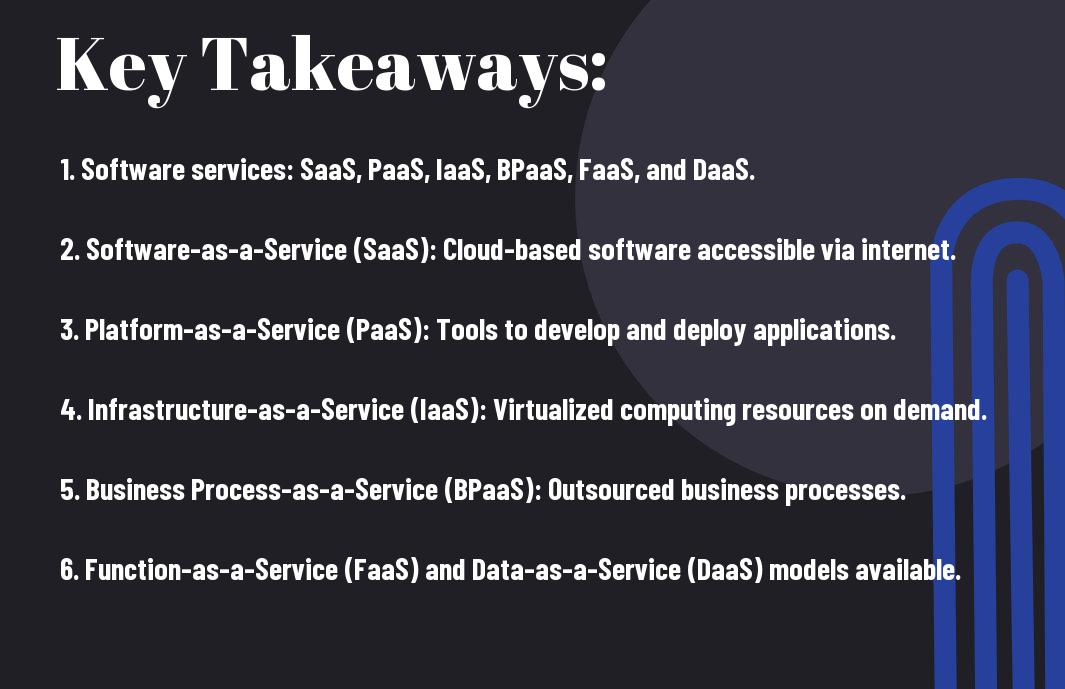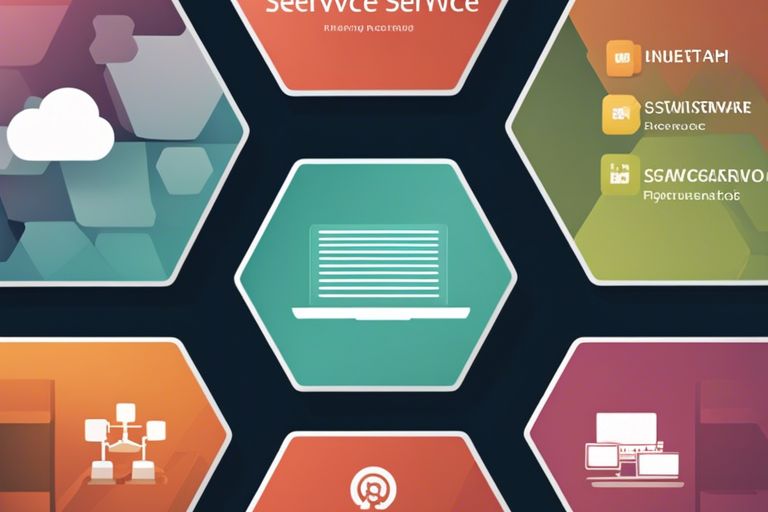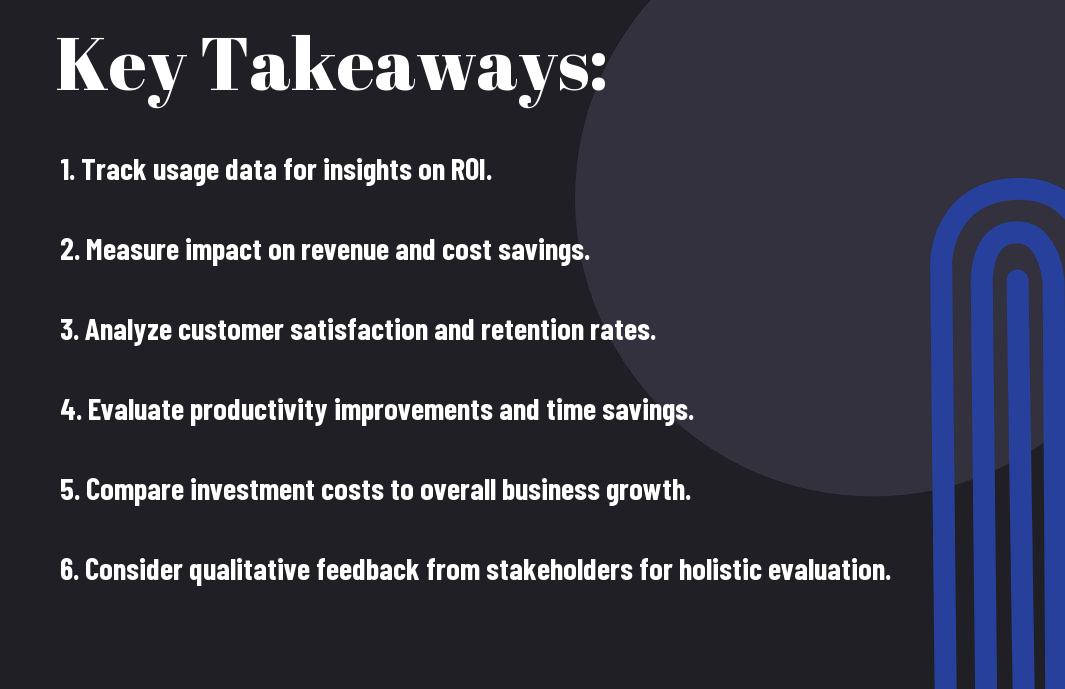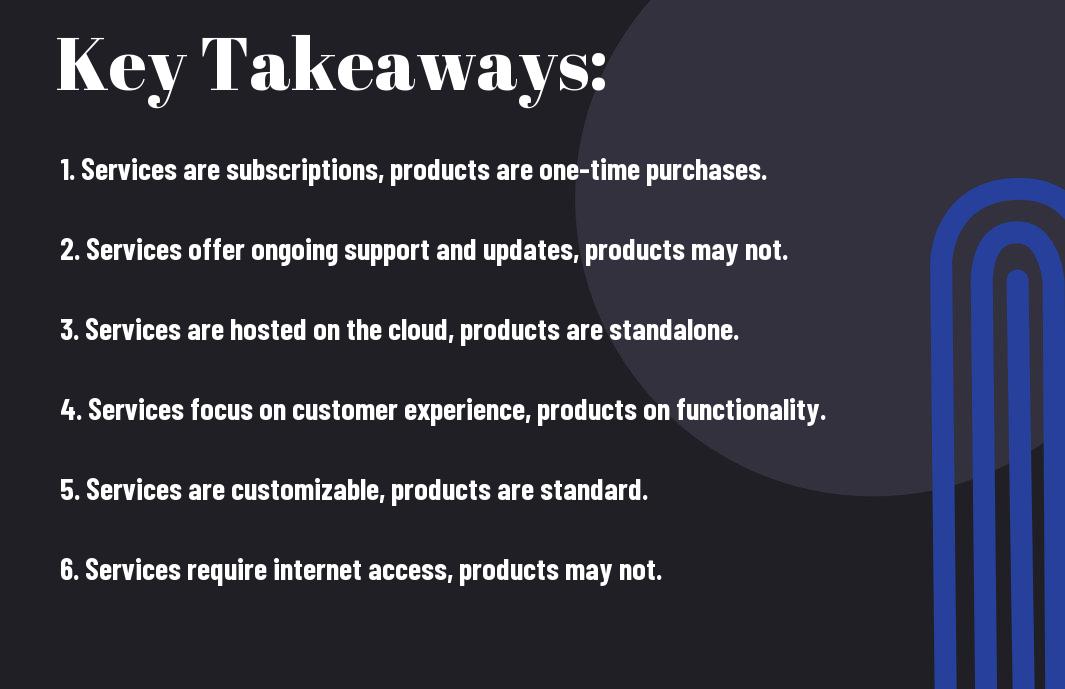Most of us rely on software services every day, but do you know the variety of options available in the market? Understanding the different types of software services can help you make informed decisions for your personal or business needs. From SaaS (Software as a Service) and PaaS (Platform as a Service) to IaaS (Infrastructure as a Service) and more, this post will break down the diverse range of software services available in today’s tech world.
Key Takeaways:
- Software as a Service (SaaS): SaaS is a cloud-based software distribution model where applications are hosted by a third-party provider and made available to customers over the internet.
- Platform as a Service (PaaS): PaaS provides a platform allowing customers to develop, run, and manage applications without the complexity of building and maintaining the infrastructure.
- Infrastructure as a Service (IaaS): IaaS offers virtualized computing resources over the internet, allowing customers to rent servers, storage, and networking on a pay-as-you-go basis.

On-Premise Software Services
Definition and Characteristics
On-Premise software services, also known as on-premises software, refer to software that is installed and operated from your organization’s in-house server and computing infrastructure. This means that you are responsible for managing and maintaining the software, as well as the hardware it runs on, within your own premises.
One of the key characteristics of on-premise software services is that they offer greater control and customization options for your organization. You have the flexibility to tailor the software to meet your specific business requirements and have full control over security measures to protect your data.
Advantages and Disadvantages
The main advantage of on-premise software services is the level of control and security it provides. Since the software and data are stored within your premises, you have more control over access and can implement security measures according to your organization’s standards.
However, one of the disadvantages of on-premise software services is the higher upfront costs involved in purchasing and setting up the necessary infrastructure. Additionally, maintenance and upgrades may require dedicated IT staff and resources, which can add to the total cost of ownership over time.
Characteristics of on-premise software services include the ability to customize the software to your organization’s specific needs, greater control over data security and privacy, and the potential for higher upfront costs and ongoing maintenance requirements.
Cloud-Based Software Services
Definition and Characteristics
Some of the most common types of software services available in the market today can be found in the cloud. Cloud-based software services refer to applications that are hosted on remote servers and accessed over the internet. This type of software is popular because it allows you to access your data and programs from anywhere, at any time, as long as you have an internet connection. Whether you are using Top 10 Common Types of Business Software or other cloud-based solutions, these services offer convenience and scalability for your business needs.
Advantages and Disadvantages
One of the main advantages of cloud-based software services is the flexibility they provide. You can easily scale your usage up or down based on your needs, and you only pay for what you use. Additionally, cloud-based software services often come with automatic updates and maintenance, saving you time and resources. However, a potential disadvantage is the reliance on internet connectivity. If you have a poor connection, you may experience disruptions in accessing your software and data.
Public, Private, and Hybrid Cloud Options
Software services in the cloud are generally categorized as either public, private, or hybrid. Public clouds are owned and operated by third-party providers and offer services to multiple users. Private clouds, on the other hand, are dedicated to a single organization and offer more control and customization. Hybrid clouds combine elements of both public and private clouds, allowing you to take advantage of the benefits of each. Depending on your business needs and security requirements, you can choose the cloud option that best suits you.
SaaS (Software as a Service) Model
Despite the various types of software services available in the market today, Software as a Service (SaaS) has gained significant popularity. SaaS is a software delivery model where the software is hosted on the cloud and made available to users over the internet.
Definition and Characteristics
For SaaS, you do not need to install or maintain the software on your own devices. Instead, you access the software through a web browser, making it convenient and accessible from anywhere with an internet connection. SaaS providers handle maintenance, updates, and security, allowing you to focus on using the software rather than managing it.
Benefits and Drawbacks
Any organization can benefit from SaaS due to its scalability, cost-effectiveness, and ease of use. You can easily scale your usage based on your needs, pay for what you use through a subscription model, and enjoy regular updates and support from the provider. However, drawbacks include dependency on the provider’s infrastructure and potential data security concerns.
Software as a Service provides a flexible and customizable solution for a wide range of business needs. It allows you to access a variety of applications such as customer relationship management (CRM), project management, and collaboration tools without the hassle of traditional software installation and maintenance.
Examples of SaaS Providers
Characteristics of SaaS providers include names like Salesforce for CRM, Google Workspace for productivity tools, and Microsoft Office 365 for office applications. These providers offer a range of services that cater to different business requirements, providing flexibility and efficiency in managing your software needs.
Another benefit of using SaaS providers is the ability to easily integrate with other software solutions and services, creating a seamless workflow across your business operations. This interconnectedness can improve productivity and streamline processes for your organization.

PaaS (Platform as a Service) Model
Now, if you want to understand more about the various types of software services available in the market today, you can refer to a comprehensive list of ’16 Types of Software: What They Are and How To Use Them’ on Indeed.
Definition and Characteristics
The Platform as a Service (PaaS) model offers a platform allowing customers to develop, run, and manage applications without the complexity of building and maintaining the infrastructure typically associated with developing and launching an app. PaaS provides a framework that developers can build upon to develop or customize applications.
Benefits and Drawbacks
The main benefit of PaaS is that it provides a complete platform for developers to build applications without having to worry about the underlying infrastructure. This can lead to faster development times, cost savings, and scalability. However, one drawback of PaaS is that it can limit the flexibility of development, as developers are confined to the platform’s features and tools.
The Platform as a Service model offers a platform where you can focus on developing your applications without having to manage the underlying infrastructure. This means that you can quickly deploy your applications, scale them as needed, and leverage the tools and services provided by the PaaS provider.
Examples of PaaS Providers
Benefits of using PaaS include access to a wide range of development tools, libraries, and APIs that can help speed up your development process. Some popular PaaS providers include Microsoft Azure, Google App Engine, and Heroku.
Providers like Microsoft Azure, Google App Engine, and Heroku offer PaaS solutions that cater to different development needs and preferences. By choosing the right PaaS provider, you can streamline your development process and focus on building great applications without worrying about the underlying infrastructure.

IaaS (Infrastructure as a Service) Model
Many software services in the market today follow the IaaS (Infrastructure as a Service) model. This model provides virtualized computing resources over the internet. With IaaS, you can rent IT infrastructure such as servers, storage, and networking on a pay-as-you-go basis, allowing you to scale your resources up or down based on your needs.
Definition and Characteristics
For IaaS, the service provider manages the infrastructure, while you are responsible for operating systems, applications, and data. This gives you more flexibility and control over your IT environment without the cost and complexity of owning and maintaining physical servers.
Benefits and Drawbacks
IaaS offers numerous benefits such as scalability, flexibility, and cost-effectiveness. You can quickly deploy new applications and scale resources according to demand, all while paying only for what you use. However, drawbacks include potential security concerns as data is stored off-premises and reliance on the service provider for infrastructure availability and performance.
Infrastructure as a Service (IaaS) providers offer virtualized computing resources, storage, and networking services. You can choose from a variety of providers, each offering different features, pricing models, and service levels to meet your specific requirements.
Examples of IaaS Providers
With providers like Amazon Web Services (AWS), Microsoft Azure, and Google Cloud Platform, you can access a wide range of infrastructure services to build, deploy, and manage your applications. These providers offer global data centers, high availability, and robust security features to ensure your applications run smoothly and securely.
Examples of IaaS Providers include Amazon Web Services (AWS), Microsoft Azure, Google Cloud Platform. These providers offer a wide range of services such as virtual servers, storage solutions, and networking capabilities to support your IT infrastructure needs. With their pay-as-you-go pricing models and extensive service offerings, you can easily scale your resources and grow your business without the burden of managing physical hardware.
Open-Source Software Services
Definition and Characteristics
The world of software services offers a wide array of options, one of which is open-source software. The hallmark of open-source software is that its source code is freely available for anyone to view, modify, and distribute. This collaborative model allows for continuous improvement by a community of developers and users, fostering innovation and creativity.
Advantages and Disadvantages
Open-source software comes with both advantages and disadvantages. On the positive side, using open-source software can lead to cost savings as it is typically free to use. Additionally, the transparent nature of the source code allows for greater customization and flexibility in tailoring the software to your specific needs. However, open-source software may lack formal support and documentation compared to proprietary software, which can pose challenges for users who require technical assistance or troubleshooting.
Open-source software inherently promotes transparency, which can enhance security and reliability. Since the source code is open for review by anyone, security vulnerabilities can be identified and fixed quickly by the community. This can result in more robust and secure software compared to closed-source alternatives.
Examples of Open-Source Software
The open-source community has produced a wide range of software across various categories. Some popular examples of open-source software include the Linux operating system, the Apache web server, the Mozilla Firefox web browser, and the LibreOffice productivity suite. These tools have gained popularity for their stability, customizability, and community-driven development.
Open-source software is not only widespread but also plays a significant role in shaping the technology landscape. By fostering collaboration and innovation, open-source software continues to be a driving force behind many digital advancements in today’s interconnected world.
Final Words
Presently, you have gained insight into the various types of software services available in the market today. These services range from traditional on-premises software to cloud-based solutions like Software as a Service (SaaS), Platform as a Service (PaaS), and Infrastructure as a Service (IaaS). Each type offers unique benefits and considerations based on your specific needs and requirements. If you want to investigate deeper into Software as a Service (SaaS), you can learn more about it here.
FAQ
Q: What is custom software development?
A: Custom software development involves creating tailored software solutions to meet specific business requirements. It is designed from scratch to address a company’s unique needs and is usually developed by a third-party provider or an in-house team.
Q: What is Software as a Service (SaaS)?
A: Software as a Service (SaaS) is a cloud-based software delivery model where applications are hosted by a third-party provider and made available to customers over the internet. Users can access and use the software on a subscription basis, eliminating the need for on-premises installation and maintenance.
Q: What is Platform as a Service (PaaS)?
A: Platform as a Service (PaaS) is a cloud computing model that provides a platform allowing customers to develop, run, and manage applications without the complexity of building and maintaining the infrastructure typically associated with developing and launching an app. PaaS offers tools and services to streamline the development process and accelerate time-to-market for new software applications.
















